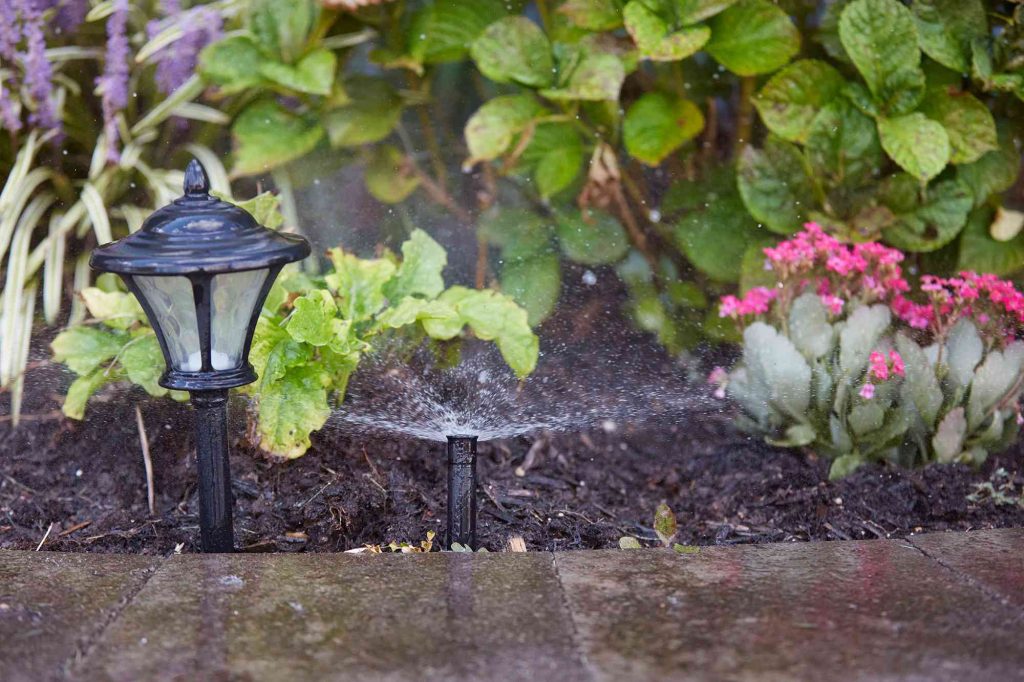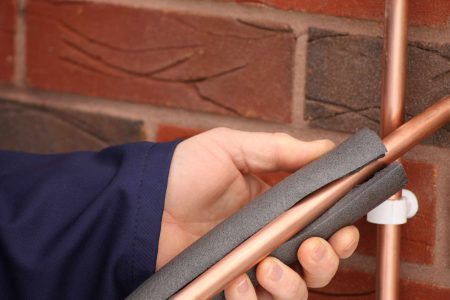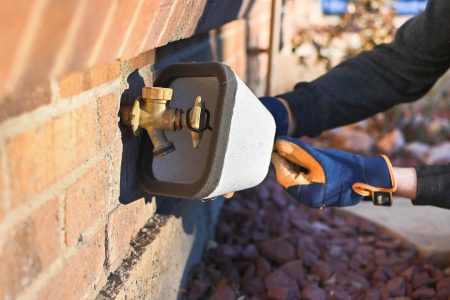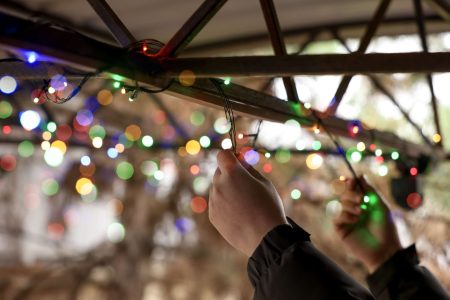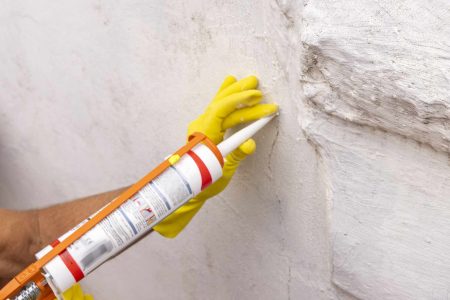Underground lawn and landscape irrigation systems may seem complex, but the principles by which they operate are fairly simple, and understanding a little about the system will help you understand the problems that can occur. With rare exception, most homeowners will find it possible to repair these problems themselves, but the first step is to identify the source of the problem—and this begins with understanding the components and how they work together.
Before You Begin
An in-ground lawn sprinkler system consists of several key components. In the typical system, a water supply pipe from the main water source first passes into a valve box set at ground level, where it is divided into individual underground irrigation zones, each controlled by its own zone valve. The zone valves are governed by an electronic controller, which sets the time and duration of each watering session via low-voltage wires. Smaller homes may have just one irrigation zone, but most have two, three, or more.
The zone valves themselves consist of a diaphragm that controls the flow of water; the diaphragm is open and closed based on signals received by a solenoid mounted on the zone valve. The solenoid controls a spring-loaded metal piston that opens or closes the water port passing through the valve. Irrigation zone valves come in many shapes and configurations, including models that integrate an anti-siphon device. In other systems, the anti-siphon valve is a separate device that is installed on the water pipe before it reaches the valve box.
When a zone valve opens, water flows through underground plastic tubing to feed sprinkler heads that pop up and distribute water to the lawn and landscape for however long the controller allows the zone valve to remain open.
Problems with an irrigation system typically make themselves evident with several common symptoms:
- Individual sprinkler heads not working
- Low water pressure at the sprinkler heads
- Sprinkler zones do not turn on
- Leaking around a zone valve
- Leak at the sprinkler head furthest from the valve
What You’ll Need
Equipment / Tools
- Screwdrivers
- Multimeter
- Shovel (as needed)
Materials
- New diaphragm (optional)
- New zone valve (optional)
Instructions
Troubleshooting a lawn sprinkler system involves carefully observing the signs of the problem. This will usually steer you to the nature of the problem and the solutions to it.
Once the particular cause of the problem is identified, find the manufacturer’s name on the unit and consult their website (or the print manual) for specific instructions on repair or replacement of the problem unit. General solutions are outlined here, but if you need more information to fix the system, consult the manufacturer’s guidance.
If Individual Sprinkler Heads Aren’t Working
One of the most common problems with a lawn irrigation system is when sprinkler heads get damaged, which is usually easy to spot. Damage to sprinkler heads is very common if the heads are set too high and are run over by lawnmowers or cars.
-
Find the Issue
First, confirm that a broken sprinkler head is the problem. Look for:
- Damage to the plastic casing on the sprinkler heads
- Sprinkler heads that don’t pop up
- Water that sprays wildly or not at all
- Sprinklers with heads that are completely broken off
-
Clear the Sprinkler Head
Once you’ve found the damaged head, clean it of any debris and reset its spray pattern. Watch the spray head on its next timer cycle to see if the spray head performs correctly. If not, the sprinkler head will likely need to be replaced.
-
Replace the Sprinkler Head (If Needed)
If, after cleaning and resetting the head, it’s still not working, replace it. This is very often a matter of just unscrewing the sprinker head from the riser tube, then screwing a new one on.
If the Sprinklers Are Producing Low Water Pressure
This problem shows itself in sprinkler heads that barely spray water. Sometimes, the heads will not even pop up. There are a number of possible causes and solutions.
-
Check the Backflow Device
To determine if the backflow device is malfunctioning, first make sure the water valves at the backflow device are turned fully on. The backflow device is normally located above ground, just above where the water pipe descends down to the valves that split the water into separate sources.
-
Look for Water Pipe Leaks
A more serious cause is when there is a water pipe leak somewhere along one of the underground irrigation lines. Such water line problems are usually located somewhere between the valves and the first sprinkler head. You may find areas of soggy lawn where water is pooling or even gurgling up. This is the point where you will need to dig down and repair the water line.
-
Find Issues in the Irrigation Line
If no obvious leak is apparent, the irrigation line may be crushed or compressed so that the water flow has been restricted. This can be caused by tree roots or because a vehicle has compressed the soil and compressed the pipe. The only option here is to systematically dig up the lawn until you find the bad pipe and replace it.
If Sprinkler Zones Do Not Turn On
When the sprinkler zones do not turn on at all, it is generally a problem with the electrical signals running from the controller to the valve solenoids. More rarely, it is caused by a faulty valve that needs to be rebuilt or replaced.
If Only a Single Zone Is Inactive
-
Check the Voltage
The problem may be with insufficient voltage to the terminals that feed the wires leading to the valve for the problem zone. You can use a multimeter to test between the common terminal and zone terminal—if the voltage is too low (they should be between 24 to 28 volts) you will need to replace the entire controller.
-
Consider the Low-Voltage Wires
The low-voltage wires leading from the controller to the zone valve’s solenoid may be damaged or disconnected. Check the wires and make sure they are intact and properly connected to both the controller and the zone valve solenoid.
-
Inspect the Valve Solenoid
The solenoid on the valve may be faulty. In this case, you will need to replace the solenoid. With the controller in the OFF position, simply remove the wires on the solenoid and unscrew it from the valve. Screw on a new solenoid and reconnect the wires.
-
Check the Sprinkler Valve
The valve itself may need to be rebuilt or replaced. In some cases, simply disassembling and cleaning the diaphragm will solve the problem. In other cases, replacing the diaphragm and spring will be the fix. In severe cases, replacing the entire valve will be the solution.
If Multiple Zones Are Inactive
-
Test the Transformer
The problem may be with the transformer that supplies low-voltage power to the controller. Use a multitester to test the wire terminals marked “24-vac.” If the reading is below about 22 volts, you will need to replace the transformer.
If There Is Leaking Around the Zone Valve
Leaking around a zone valve could be caused by several issues.
-
Tighten Screws
On valves where the anti-siphon device is built into the valve, the problem may be resolved simply by tightening the screws holding the cover to the body of the valve.
-
Install a New Diaphragm
Leaking can be caused by a torn or damaged diaphragm inside the valve. In this case, disassemble and rebuild the valve with a new diaphragm.
-
Check the Zone Valve
A cracked valve body can cause leaking. In this circumstance, replace the zone valve.
If There’s a Leak at the Sprinkler Head Farthest From the Zone Valve
When there is standing water or leaking water at the sprinkler furthest from the sprinkler zone valves, there are a few possible causes.
-
Check the Sprinkler Head
The leaking could be caused by a dirty or damaged sprinkler head that needs to be cleaned or replaced. Inspect the head and correct any problems you find.
-
Rebuild the Zone Valve
A worn-out or damaged zone valve can also cause this issue. It may be a sign that the valve is failing to close completely. Dissemble, clean, and rebuild the valve. If this does not solve the problem, the valve may need to be replaced.
-
Look at the Flow Direction of the Valve
A valve that is installed backward may also cause this problem. Check the valve to make sure the flow direction is correct.
Read the full article here



